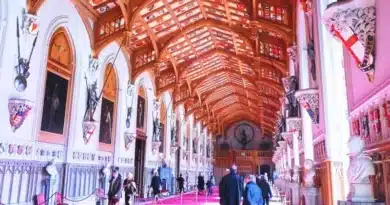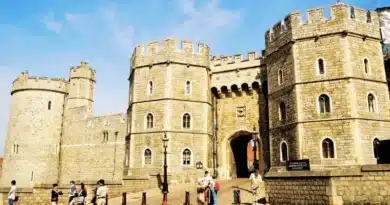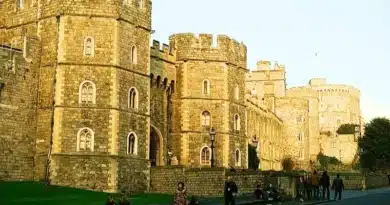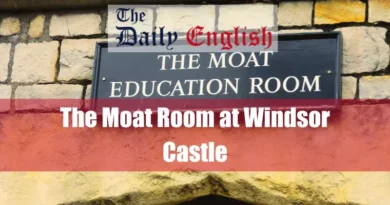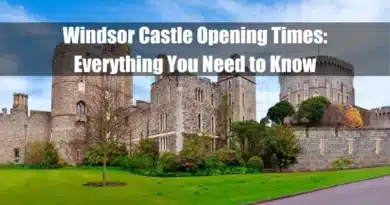How Old is Windsor Castle?
Windsor Castle, located in Berkshire, England, was originally constructed by William the Conqueror around 1070, making it over 950 years old (approximately 955 years old in 2025). It holds the distinction of being the oldest and largest inhabited castle in the world and has been the residence of 39 British monarchs. The castle has undergone numerous modifications and expansions over the centuries, reflecting successive monarchs’ architectural styles and preferences. Today, it remains a significant royal residence and a popular tourist attraction, embodying nearly a millennium of British history.
Key Takeaways
| A Historical Timeline |
|---|
| 11th Century (Foundation): William the Conqueror established Windsor Castle as a defensive fortress shortly after the Norman Conquest. |
| Medieval Period: Subsequent monarchs developed the castle, adding stronger fortifications, living quarters, and chapels. It became a base for hunting and royal activities. |
| Tudor Period: Significant renovations transformed Windsor into a grand palace. Henry VIII spent large sums, making it a symbol of royal power and prestige. |
| Stuart Period: During the English Civil War, Windsor Castle was used as a parliamentary headquarters and prison. After the monarchy was restored, Charles II remodelled and restored parts of the castle. |
| Georgian Period: George III and George IV modernised and expanded the castle, reflecting changing tastes. It became a more comfortable and fashionable royal residence. |
| Victorian Period: Queen Victoria extensively used Windsor Castle, especially after Prince Albert’s death, turning it into a retreat and a symbol of the British Empire. Many renovations were made during this period. |
| 20th and 21st Centuries: Windsor Castle remains a royal residence and hosts state occasions. It has also become a major tourist attraction and a venue for significant events such as royal weddings and state visits. |
| Windsor Castle illustrates its evolution across centuries to meet the needs of different eras, symbolising the long history and ongoing presence of the British monarchy. |
Origins and Early Construction

Following his decisive victory at the Battle of Hastings in 1066, William the Conqueror sought to consolidate his control over England. He commissioned a series of motte-and-bailey castles to secure key positions and establish a defensive network around London. Windsor Castle was among these, strategically situated near the River Thames and adjacent to Windsor Forest, a royal hunting preserve. The initial structure was primarily wooden, featuring a keep atop a man-made motte (mound) and a surrounding bailey (enclosed courtyard). This design was typical of Norman military architecture, emphasising both defence and rapid construction.
The motte-and-bailey design, characterised by a wooden or stone keep situated on a raised earthwork called a motte, accompanied by an enclosed courtyard or bailey, was a hallmark of Norman military architecture. This design facilitated rapid construction and provided formidable defensive capabilities. The Normans introduced this type of fortification to England during their conquest, with Windsor Castle being a prime example. Its strategic location near the River Thames and proximity to Windsor Forest underscored its importance in controlling movement and asserting Norman dominance in the region.
The initial construction of Windsor Castle involved erecting a wooden keep atop a man-made motte surrounded by a protective bailey. This method allowed for the swift establishment of control points across the newly conquered territories. Over time, these wooden structures were replaced or reinforced with stone, enhancing their durability and defensive strength.
Windsor Castle’s evolution from a wooden fortification to a stone fortress reflects the broader transition in Norman castle-building practices during their consolidation of power in England.
Transition to Stone and Medieval Enhancements

By the late 12th century, Windsor Castle underwent significant transformations as its wooden fortifications were progressively replaced with stone, enhancing both durability and defensive capabilities. During the reign of Henry II (1154–1189), extensive construction took place between 1165 and 1179. Henry II replaced the wooden palisade surrounding the Upper Ward with a stone wall interspersed with square towers and built the first King’s Gate. Additionally, he addressed structural issues by replacing the original stone keep, which had suffered from subsidence, with a new stone shell keep, moving the walls inward from the edge of the motte to alleviate pressure on the mound. Massive foundations were added along the south side to provide additional support. Inside the castle, Henry II remodelled the royal accommodation, utilising Bagshot Heath stone for most of the work and stone from Bedfordshire for the internal buildings.
His successor, King John (1199–1216), further enhanced Windsor Castle, particularly in the context of the tensions leading up to the sealing of the Magna Carta in 1215. The castle’s proximity to Runnymede, where the charter was sealed, underscores its strategic importance during this period. King John undertook building works primarily for the accommodation rather than the defences, using the castle as his base during the negotiations before the signing of the Magna Carta. In 1216, the castle was besieged by baronial and French troops under the command of the Count of Nevers, but John’s constable, Engelard de Cigogné, successfully defended it.

Subsequent monarchs continued to invest in Windsor Castle’s development. Henry III (1216–1272) rebuilt some of the walls in stone, created a new gatehouse, and erected three new towers on the site.
He also constructed a luxurious palace between 1240 and 1263, based around a court along the north side of the Upper Ward, intended primarily for the queen and Henry’s children. In the Lower Ward, Henry III ordered the construction of a range of buildings for his own use along the south wall, including a 70ft (21m) long chapel, later called the Lady Chapel. This was the grandest of the numerous chapels built for his use, comparable to the Sainte-Chapelle in Paris in size and quality. Henry’s work was characterised by rich decorations, forming “one of the high-water marks of English medieval art”. The conversion cost more than £10,000, creating a division in the castle between a more private Upper Ward and a Lower Ward devoted to the public face of the monarchy.
These medieval enhancements fortified Windsor Castle and transformed it into a symbol of royal authority and a prominent royal residence, reflecting the evolving needs and ambitions of the English monarchy during the Middle Ages.
The Age of Edward III and the Birth of the Order of the Garter
The 14th century was a transformative era for Windsor Castle, particularly during the reign of Edward III (1327–1377). Born at Windsor, Edward III had a profound connection to the castle. He embarked on an ambitious reconstruction project, investing substantial resources to transform it into a royal chivalry and power symbol. In 1348, he established the Most Noble Order of the Garter, England’s highest Order of chivalry, with Windsor Castle as its spiritual home. St George’s Chapel, constructed during this period, became the Order’s ceremonial venue, further cementing the castle’s status as a centre of medieval chivalric culture.
The Order of the Garter, dedicated to the image and arms of Saint George, England’s patron saint, is Britain’s oldest and most senior Order of chivalry. Appointments are made at the sovereign’s discretion, typically in recognition of national contribution, service to the Crown, or distinguished personal service to the monarch. Membership is limited to the sovereign, the Prince of Wales, and no more than 24 living members or Companions. The Order also includes Supernumerary Knights and Ladies, such as members of the British royal family and foreign monarchs.

The Order’s emblem is a garter circlet with the motto “Honi soit qui mal y pense” (Anglo-Norman for “Shame on him who thinks evil of it”) in gold script. Members of the Order wear it on ceremonial occasions.
St George’s Chapel in Windsor serves as the mother church of the Order of the Garter and the location of special services related to the Order. All members are entitled to display their heraldic crests and banners in the chapel during their lifetime. While the Garter stall plates remain in the chapel permanently, the crests and banners of deceased knights are removed following a presentation at the High Altar. These items are sometimes given to institutions connected with the late knight or kept privately, depending on family wishes.
The Order of the Garter continues to be celebrated annually with a procession and service on the grounds of Windsor Castle, maintaining its historical significance and traditions.
For a more in-depth understanding of the foundation of the Order of the Garter and Edward III’s role, you might find the following video informative:
Tudor and Stuart Periods: Royal Residence and Renovations
During the Tudor era, Windsor Castle remained a significant royal residence, with monarchs such as Henry VIII (1509–1547) and Elizabeth I (1558–1603) frequently utilising its facilities. Henry VIII made notable additions, including the construction of the gate that bears his name at the Lower Ward and a timber terrace along the north side of the Upper Ward, providing the King with a vantage point to observe hunts in the park below.
Elizabeth I is reputed to have used Windsor Castle as a refuge during the plague in London. To deter refugees from following her, gallows were reportedly erected on Windsor High Street, a spot now marked by stocks outside the tourist information centre. The castle underwent various modifications during this period to accommodate the monarchy’s evolving tastes and requirements.

In the subsequent Stuart period, further enhancements were made, particularly under Charles II (1660–1685). Following the Restoration of the monarchy, Charles II sought to modernise Windsor Castle, transforming its interiors into a lavish Baroque palace that could rival the opulence of European courts. He commissioned extensive renovations, including the creation of extravagant Baroque interiors, which were among the most elaborate ever executed in England. These works were part of a broader effort to restore and enhance royal residences after the English Civil War and Interregnum disruptions.
These periods were marked by significant architectural and cultural developments at Windsor Castle, reflecting the monarchy’s desire to adapt and showcase its power and prestige through the ages.
Georgian Era and the Gothic Revival
During the Georgian era, Windsor Castle underwent significant transformations, reflecting the monarchy’s evolving tastes and priorities. George III (1760–1820) initiated repairs and alterations to the castle, addressing structural concerns and modernising certain aspects to suit the royal household’s needs. His efforts marked the beginning of a renewed royal interest in the castle’s maintenance and functionality.
His son, George IV (1820–1830), profoundly impacted Windsor Castle’s architectural legacy. Embracing the Gothic Revival style, George IV sought to transform the castle into a symbol of romantic medievalism, aligning with the era’s aesthetic movements. In 1824, he commissioned architect Sir Jeffry Wyatville to undertake extensive renovations. Wyatville’s designs included the addition of crenellations, turrets, and towers, reshaping the castle’s silhouette to embody the Gothic Revival ethos.
The south front of the Upper Ward was notably transformed during this period. Internally, Wyatville reimagined the State Apartments, enhancing their grandeur to reflect contemporary tastes while honouring medieval aesthetics. For instance, Sir Walter Scott is said to have inspired the Romantic Gothic design of St George’s Hall. These refurbishments not only revitalised the castle’s appearance but also reinforced its status as a principal royal residence.
The comprehensive remodelling under George IV and Wyatville’s direction significantly influenced Windsor Castle’s present appearance, blending historical architectural elements with 19th-century innovations. This renewal period ensured the castle’s continued prominence in British royal life and its enduring legacy as a national symbol.

Victorian Developments and Modernisation
During the Victorian era, Windsor Castle underwent significant transformations under Queen Victoria and Prince Albert, solidifying its status as a central symbol of the British monarchy. Despite initial reservations—Victoria once described the castle as “dull and tiresome”—the royal couple chose it as their principal residence, elevating its prominence in national affairs.
The castle became a hub for state occasions and royal ceremonies, reflecting the expanding British Empire and Victoria’s close dynastic ties to Europe. The advent of railways and steamships facilitated numerous diplomatic visits, with Windsor often hosting prominent figures invited to “dine and sleep” at the castle. Victoria took a keen interest in the castle’s operations and meticulously oversaw social events, although the excessive formality and the castle’s design sometimes made these occasions uncomfortable for guests.

Prince Albert’s death in 1861 deeply affected the Queen, leading to a prolonged mourning period at Windsor. Albert passed away in the Blue Room of the castle and was interred in the Royal Mausoleum at Frogmore. Victoria preserved his rooms as they were at the time of his death, earning her the moniker “Widow of Windsor,” popularised by Rudyard Kipling. During this time, the castle’s social activities diminished, with Victoria shunning Buckingham Palace and conducting official business from Windsor. Towards the end of her reign, the castle slowly reintroduced plays, operas, and other entertainments, balancing the Queen’s desire for seclusion with her need for diversion.
Several architectural modifications were made during Victoria’s tenure. Anthony Salvin rebuilt Wyatville’s grand staircase, and Edward Blore constructed a new private chapel within the State Apartments. Salvin also rebuilt the State Dining Room following a significant fire in 1853. Ludwig Gruner contributed to the Queen’s Private Audience Chamber design in the south range. Under Prince Albert’s direction in the Lower Ward, the Hundred Steps leading down into Windsor town were constructed, and the Garter, Curfew, and Salisbury towers were rebuilt. Additionally, the houses of the Military Knights were renovated, and a new Guardhouse was created. George Gilbert Scott rebuilt the Horseshoe Cloister in the 1870s, and the Norman Gatehouse was converted into a private dwelling for Sir Henry Ponsonby.
Despite the era’s technological advancements, Victoria hesitated to adopt certain modern amenities. She preferred candles over gaslight, resulting in limited electric lighting installations towards the end of her reign. The castle was notoriously cold and draughty during this period. However, it was connected to a nearby reservoir, ensuring a reliable water supply piped into the interior for the first time.
The surrounding parklands also saw enhancements. The Royal Dairy at Frogmore was rebuilt in a mock Tudor style in 1853, and George III’s Dairy was reconstructed in a Renaissance style in 1859. The Georgian Flemish Farm was rebuilt, and the Norfolk Farm underwent renovations. The Long Walk was replanted with new trees to replace diseased ones. The Windsor Castle and Town Approaches Act of 1848 allowed for rerouting old roads through the park, enabling the royal family to enclose a large area of parkland, forming the private “Home Park” without public roads. The Queen granted additional public access to the remaining park areas in exchange.
These developments during Queen Victoria’s reign modernised Windsor Castle and reinforced its role as a central institution in British royal life, reflecting the monarchy’s adaptation to the changing times.
20th Century: Preservation and Adaptation
In the 20th century, Windsor Castle faced significant challenges and transformations, necessitating both preservation efforts and adaptive measures to maintain its status as a royal residence and national symbol.
World War II Precautions

During the Second World War, Windsor Castle served as a refuge for the royal family, providing a secure haven away from the bombing raids that threatened London. To safeguard the castle’s invaluable art and historical collections, several protective measures were implemented:
- Protection of the Crown Jewels: The Crown Jewels were secretly removed from the Tower of London and transported to Windsor Castle for safekeeping. Upon arrival, they were placed under the custody of the Royal Librarian, Sir Owen Morshead, who took further precautions to conceal them. Initially, the jewels were stored in leather hatboxes to disguise their contents and kept under lock and key in his office. Subsequently, in early 1941, they were transferred to a specially constructed tunnel beneath the castle to ensure their security.
- Structural Reinforcements: The castle’s robust structure was further reinforced to withstand potential attacks. Chandeliers were removed, and windows were blacked out to prevent light from escaping, reducing the risk of attracting enemy bombers.
The 1992 Fire and Restoration
On 20 November 1992, a devastating fire broke out at Windsor Castle, causing extensive damage to the structure. The blaze lasted approximately 15 hours and affected over 100 rooms, including nine State Rooms.
- Restoration Efforts: The restoration project commenced promptly, with architectural firm Donald Insall Associates appointed by the Royal Household to oversee the work. The Restoration Committee, chaired by The Duke of Edinburgh, faced decisions on restoring the castle to its pre-fire appearance or incorporating new design elements. The project was completed on 20 November 1997, exactly five years after the fire, coinciding with the 50th wedding anniversary of Queen Elizabeth II and Prince Philip.
- Funding: The restoration cost approximately £36.5 million. To fund the repairs, entrance fees covered 70% of the costs of public visits to Buckingham Palace, a measure introduced to generate revenue for the restoration.
These events in the 20th century underscored Windsor Castle’s resilience and adaptability, ensuring its preservation for future generations while maintaining its role as a functional residence for the British monarchy and a site of historical significance.
For a visual account of the 1992 Windsor Castle fire and the subsequent restoration efforts, you may find the following video informative:
Windsor Castle Today
Windsor Castle, an enduring emblem of the British monarchy, is the world’s oldest and largest occupied castle. Established in the 11th century by William the Conqueror, it has continuously served as a royal residence, adapting to successive monarchs’ evolving needs.
Today, the castle remains a central hub for royal activities. It regularly hosts state visits, ceremonial events, and royal weddings, underscoring its significance in national life. Notably, with Buckingham Palace undergoing extensive renovations until 2027, Windsor Castle has assumed an even more prominent role, accommodating state functions that would traditionally occur in London.

Beyond its official duties, Windsor Castle is a major tourist attraction, drawing visitors from around the globe eager to explore its rich history and architectural splendour. Highlights for visitors include the State Apartments, which showcase a range of historical and contemporary royal interiors, and St George’s Chapel, renowned for its Gothic architecture and as the venue for numerous royal ceremonies.
The castle’s extensive grounds, encompassing the picturesque Home Park and the iconic Long Walk, offer further attractions for visitors. The Long Walk, a tree-lined avenue stretching approximately 2.65 miles, provides a scenic route for leisurely strolls and offers stunning castle views.
Windsor Castle’s enduring presence reflects the resilience and continuity of the British monarchy. Its ability to adapt to modern requirements while preserving its historical essence stands as a testament to the nation’s storied past and its evolving present.
Conclusion
Windsor Castle’s age—spanning nearly 950 years—encapsulates a vast expanse of English history. From its origins as a Norman fortress to its current status as a working royal residence, the castle has witnessed and adapted to the profound transformations of the nation it represents. Its walls have sheltered monarchs, hosted pivotal events, and stood resilient against the tides of time, making Windsor Castle not only a symbol of royal heritage but also a testament to the enduring legacy of England itself.
FAQ
How old is Windsor Castle?
Windsor Castle was originally built by William the Conqueror around 1070, making it over 950 years old.
What makes Windsor Castle unique?
It is the world’s oldest and largest inhabited castle, serving as a royal residence for 39 British monarchs over its long history.
Who built Windsor Castle, and why?
William the Conqueror built Windsor Castle as part of a defensive network to secure his control over England after the Norman Conquest.
What architectural style did the original Windsor Castle feature?
The original castle was a motte-and-bailey design, constructed mainly of wood, typical of Norman military architecture.
When was Windsor Castle converted from wood to stone?
The transition from wood to stone began during Henry II’s reign in the late 12th century, enhancing the castle’s durability and defences.
What is the significance of St George’s Chapel?
St George’s Chapel is the spiritual home of the Order of the Garter, the oldest and most senior Order of Chivalry in Britain. Established by Edward III in 1348, it is the oldest and most senior Order of Chivalry in the country.
What major events have taken place at Windsor Castle?
Key events include sealing the Magna Carta nearby in 1215, royal weddings, state banquets, and annual Order of the Garter ceremonies.
How did Windsor Castle change during the Tudor period?
Henry VIII added the iconic Henry VIII Gate, and Elizabeth I used the castle as a refuge during the London plagues, adapting it to evolving royal needs.
What role did Windsor Castle play during World War II?
The castle was a refuge for the royal family, and the Crown Jewels were secretly stored there for safekeeping. To protect it, structural reinforcements were also made.
What happened during the 1992 Windsor Castle fire?
A fire damaged over 100 rooms, including nine State Rooms. The restoration, completed in 1997, cost £36.5 million and restored the castle’s historic appearance.
How did Queen Victoria influence Windsor Castle?
Queen Victoria made it her principal residence, hosting state events and overseeing architectural improvements despite initially finding it “dull and tiresome.”
What is the Long Walk at Windsor Castle?
The Long Walk is a scenic, tree-lined avenue stretching 2.65 miles from the castle to Snow Hill, offering picturesque views and a popular walking route.
How is Windsor Castle used today?
Windsor Castle is an active royal residence that hosts state events, royal weddings, and ceremonial occasions. It is also a major tourist attraction.
What is the connection between Windsor Castle and the Order of the Garter?
Windsor Castle is the ceremonial home of the Order of the Garter, with St George’s Chapel hosting the annual Garter Day procession and service.
What measures have been taken to preserve Windsor Castle?
Over the centuries, restoration projects, including post-fire renovations and modern utilities, have ensured the castle’s preservation as a historic and functional royal residence.





